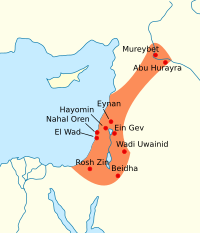
Photo from wikipedia
The Middle Pleistocene archaeological record of the southern Levant has proven key to understanding human evolution and intercontinental faunal biogeography. Knowledge of archaeological sites of that period in the southern… Click to show full abstract
The Middle Pleistocene archaeological record of the southern Levant has proven key to understanding human evolution and intercontinental faunal biogeography. Knowledge of archaeological sites of that period in the southern Levant is biased, with most Middle Pleistocene localities in the Mediterranean areas in the north, despite the mosaic of environments that mark the entire region. A key Middle Pleistocene location in the Judean Desert – on the eastern margin of the Mediterranean zone – is the site of Oumm Qatafa, excavated in the early 1900s, which yielded a faunal collection spanning an estimated time period of 600–200 kya. Here, we present a revised taxonomy of the macromammalian fauna from the site, discuss the palaeoenvironmental implications of this assemblage, and relate the finds to other Pleistocene sites from the Levant. These data enable a more precise palaeoenvironmental reconstruction which attests to an open landscape, but with the addition of a mesic Mediterranean component close by. In addition, detailed taphonomic observations on butchery marks and Fourier transform infrared spectroscopy analysis of burnt bone link the fauna for the first time to anthropogenic activities in the cave.
Journal Title: Journal of Quaternary Science
Year Published: 2022
Link to full text (if available)
Share on Social Media: Sign Up to like & get
recommendations!